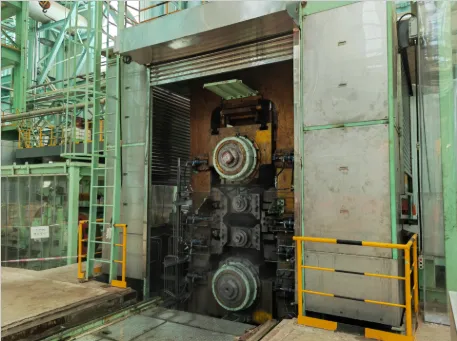
Integration of Skin Pass Mill with Tension Levelers for Flatness Control in Advanced Steel Processing
The modern steel industry faces increasing demands for high-quality flat-rolled products with exceptional surface characteristics and dimensional precision. At the heart of meeting these requirements lies the strategic integration of skin pass mill technology with advanced tension leveling systems. This synergistic combination has revolutionized flatness control in premium steel production, particularly for automotive, appliance, and specialty applications where surface quality and shape perfection are paramount.
A 4 hi skin pass mill configuration, when properly coordinated with tension levelers, provides unparalleled control over both the microstructural and geometric properties of steel strip. The skin pass rolling process, typically involving 0.5-3% reduction, works in concert with tension leveling to eliminate yield point elongation while simultaneously correcting shape defects. This integrated approach is especially critical when processing advanced high-strength steels (AHSS) and ultra-thin gauge materials where conventional methods struggle to maintain consistent quality.

Fundamental Principles of Skin Pass and Tension Leveling Interaction
The Dual Mechanism of Flatness Correction
The combination of a skin pass mill with tension levelers operates through two complementary mechanisms of flatness control. The skin pass rolling component primarily addresses microstructural modifications through controlled plastic deformation, while the tension leveler applies strategic stress distribution to correct macroscopic shape irregularities. In a 4 hi skin pass mill arrangement, the work rolls impart just enough reduction to modify surface characteristics without significantly altering the bulk material properties.
Tension levelers enhance this process by applying carefully calibrated longitudinal stresses that help redistribute internal strains across the strip width. This dual approach proves particularly effective for eliminating complex shape defects like quarter buckles, center waves, and edge curls that might resist correction through either method alone. The interaction between compressive forces in the skin pass and tensile stresses in the leveler creates an optimal condition for achieving perfect flatness.
Material Response to Combined Processing
The metallurgical effects of skin pass rolling when integrated with tension leveling are profound and multifaceted. As the material passes through the skin pass mill, it undergoes controlled work hardening that eliminates discontinuous yielding behavior. Simultaneously, the tension leveler works to homogenize residual stresses through elastic-plastic deformation mechanisms.
This combination proves particularly beneficial for processed steels that have undergone annealing, where the skin pass operation serves to re-establish desirable surface characteristics while the tension leveler ensures dimensional stability. The hot skin pass mill variant offers additional advantages for certain material grades, allowing for improved ductility during the flattening process while maintaining the benefits of surface texture control.
System Configuration and Operational Synergies of Skin Pass Mill
Mechanical Integration of Skin Pass Mills and Levelers
Modern processing lines increasingly adopt tightly integrated layouts where the skin pass mill and tension leveler function as a single coordinated system rather than separate entities. In such configurations, the 4 hi skin pass mill is typically positioned immediately upstream of the tension leveler, allowing for seamless material transfer between processes. This physical proximity reduces intermediate handling and minimizes the potential for new shape defects to develop between processing stages.
The mechanical design of these integrated systems pays particular attention to transition zones between equipment, ensuring smooth strip travel without introducing additional stresses. Advanced entry and exit loopers maintain optimal tension profiles throughout the entire processing sequence, from the initial skin pass rolling through to the final tension leveling operation. This careful mechanical integration is crucial for maintaining consistent quality, especially when processing thin gauge materials or high-strength alloys.
Control System Architecture and Coordination
The true power of combining skin pass mill technology with tension levelers lies in the sophisticated control systems that orchestrate their simultaneous operation. Modern installations feature unified control platforms that synchronize roll gap adjustments in the skin pass mill with tension and bend settings in the leveler. This coordinated control approach allows for real-time compensation of process variations that might affect flatness.
Key to this integration is the use of advanced flatness measurement systems positioned both before and after the combined processing unit. These sensors feed continuous data to the control system, enabling dynamic adjustments to both skin pass rolling parameters and leveling tensions. The system can automatically compensate for incoming material variations, ensuring consistent output quality regardless of upstream process fluctuations.
-
Indian Clients Visit YWLX to Inspect Skin-pass MillNewsJun.22,2025
-
Typical Products from Reversing Cold Rolling ProcessNewsMay.26,2025
-
Surface Finish Improvement through Skin Pass RollingNewsMay.26,2025
-
Integration of AGC Systems in Modern Cold Rolling MillsNewsMay.26,2025
-
Cold Rolling in the Context of High-Strength Steel DemandNewsMay.26,2025
-
AGC in Hot Rolling Mills: Challenges and SolutionsNewsMay.26,2025
-
Why Reversing Cold Rolling Mills Are Ideal for Specialty MetalsNewsMay.13,2025










